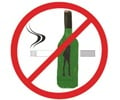The National Family Health Survey-5 indicates surprisingly that alcohol consumption is higher among men and women in rural than in urban India.
- Arunachal Pradesh has the highest alcohol consumption rates for both males (53%) and females (24%). Its consumption is lowest in Lakshadweep (0.4%) island
- In Chhattisgarh, Uttarakhand, Manipur, Meghalaya, Tripura and Odisha, men consume alcohol at the rate of 30–40%
- Its impact on health and social structure has important implication
Read More..
Alcohol Consumption in India
Alcohol Consumption is highly prevalent in all Indian states and union territories (UT) with an estimated 160 million people drinking regularly (1✔ ✔Trusted SourceAlcohol consumption in India- An epidemiological review
Go to source). ‘Alcohol abuse’ costs the Indian economy, 1.45% of its yearly gross domestic product (GDP) on average per year (15). Alcohol usage policies are governed by individual states and Union Territory in India due to lack of comprehensive national policy on the subject (2✔ ✔Trusted Source
Epidemiology, Hot Spots, and Sociodemographic Risk Factors of Alcohol Consumption in Indian Men and Women: Analysis of National Family Health Survey-4 (2015-16), a Nationally Representative Cross-Sectional Study
Go to source).
Alcohol Consumption - WHO Estimates
According to the World Health Organization (WHO), alcohol use is responsible for an estimated 3 million deaths and 5.1% of Disability-Adjusted Life Years (DALYs) loss worldwide each year.In terms of risk variables connected to fatalities and DALYs in 2016, alcohol intake was placed seventh. Alcohol consumption is a prominent cause of disease burden and health loss globally. In particular, malignancies, liver cirrhosis, and cardiovascular problems like myocardial infarction, ischemic stroke, high blood pressure , coronary heart disease, and hemorrhagic stroke - have all been associated to alcohol usage. A rise in traffic accidents is also tangentially tied to excess alcohol use (3✔ ✔Trusted Source
Alcohol
Go to source).
National Family Health Survey-5 Findings on Alcohol Consumption
Surprisingly according to the National Family Health Survey-5 (NFHS-5), 2019–21, alcohol consumption is higher among men and women in rural India than in urban India.In general, 1% of women who are 15 or older and 19% of men in the same age range use alcohol. For women, this breaks down to 1.6% (rural) and 0.6% (urban), whereas for men, it is 19.9% and 16.5%, respectively.
The survey found that 30–40% of men in some areas of Chhattisgarh, Uttarakhand, Manipur, Meghalaya, Tripura, and a few districts of Odisha consume alcohol.
Arunachal Pradesh had the highest alcohol consumption rates for both males (53%) and females (24%), out of all the states. Sikkim (16%) is Arunachal Pradesh's closest rival among women, whereas Telangana (43% of men) is its closest rival among men. In addition to Arunachal and Telangana, the Chhota Nagpur region of Jharkhand and Odisha, as well as the upper Brahmaputra region of Assam, have higher rates of male alcohol use (40% and above). Alcohol consumption lowest (0.4%) in Lakshadweep.
Alcohol use is more prevalent among Scheduled Tribes members than among members of any other caste or tribe, and this is true for both men (33%) and women (6%).
Men who identify as "other religions" (47%) are more likely to drink alcohol than men who identify as Hindu (20%), Muslim (5%), Christian (28%), Sikh (23.5%), Buddhist/Neo-Buddhist (24.5%), or Jain (5.9%), among other religious groups (4✔ ✔Trusted Source
National Family Health Survey (NFHS-5) 2019-21
Go to source).
Alcohol Consumption Trend from 2015 to 2020 in India
NFHS-5 report indicates that alcohol consumption among men in India seems to have decreased by 7% since 2015. According to the previous National Family Health Survey-4 from 2015-2016, 29.2% of men and 1.2% of women were found to consume alcohol. Alcohol use was more than 50% in North East India and Eastern peninsular states, like Telangana and Chhattisgarh.Global Data on Alcohol Consumption
The eastern Mediterranean region, which encompasses Afghanistan, Bahrain, and Egypt, has the lowest frequency of alcohol intake (6.5%) compared to Europe, where it is at its peak (7.5%).Alcohol is a major cause of mortality and has been linked to -
- 50% of deaths from liver cirrhosis,
- 30% of deaths from oral and pharyngeal cancer,
- 22% of deaths from interpersonal violence,
- 22% of deaths from self-harm,
- 15% of deaths from traffic accidents,
- 12% of deaths from tuberculosis (TB),
- And 12% of deaths from liver cancer worldwide.
Medical Effects of Alcohol Consumption
The stomach and small intestine absorb alcohol when alcoholic beverages are ingested. It is delivered by blood flow to every organ of the body. Most of the ingested alcohol (95% to 98%) is eliminated by the kidneys after it is rapidly absorbed by the liver.The different health issues brought on by alcohol drinking include:
- Vomiting is a gastrointestinal (GI) consequence of acute gastritis, which is typically accompanied by binge drinking.
- Changes to the genitourinary system: Short-term, low-dose ethanol use can both boost men's libido but continued consumption diminish their ability to erection. As William Shakespeare in Macbeth says ~ ‘it provokes the desire, but it takes away the performance’
- Between 50 and 70 percent of alcoholics may experience skeletal muscular weakness as a result of acute alcoholic myopathy.
- Neurological complications: After ceasing alcohol use, the short-term consequences of alcohol intake, such as blackouts, blurred vision, memory loss , and decreased reaction times, can be alleviated.
- Psychiatric complications: Chronic use can lead to increased risk for suicide and make them prone to accidents due to risk-taking behaviour and personality disorders.
Social Impact of Alcohol Consumption
Alcohol usage has an impact on not only the health but also on the social fabric. Studies show that children of alcoholic fathers will have strained relationships with their family members, which can affect their psychological wellbeing.The person intoxicated may engage in domestic violence with his family members; may deplete the family's savings, which can have a negative impact on the education of his children (1✔ ✔Trusted Source
Alcohol consumption in India- An epidemiological review
Go to source).
The increase in alcohol consumption in areas with low income and growth is a ‘double whammy’ for India. On one side it means less money for the family to meet the essential basic requirements and on the other it means, that its short and long term effects on health means increases spending.
Alcohol Dependency by States and the Tax Trap
In India, excessive alcohol intake is becoming a significant public health problem and the policy makers are well aware of this fact. This is the reason why some states have strict prohibition and others impose high taxation. However, most states earn as much as 15% of their revenues from alcohol excise duties. The sale of alcohol during the lockdown due to the COVID pandemic soared, so much so that in middle of lockdown, some states used it as an opportunity to open more liquor stores (Times of India, 2020, May 6) to earn revenue. In Tamil Nadu the government’s earning from liquor sales from excise and VAT was ₹31,157 crore and it was with an increase of 16% over the previous fiscal. There is also money to be made by auctioning the liquor stores. In some instances this may help the local legislators too in more than one way. The irony is that on one side, the government spends money for welfare of its citizens but on the other it fills its coffers from revenue that is made from alcohol.What is even worse is that the highest alcohol abuse comes from scheduled tribes and states that are low in per capita income and thus can be devastating for the growth and development of the region.
Is there a solution
To better comprehend the issue, a multi-centric scientific community-based research investigations must be carried out in several different states. States such as Bihar and Gujarat are ‘dry states’ as was Tamil Nadu once, it may be worth looking at these over-regulated states too and study its impact on public health.More sensitization programs and health education initiatives are required and legislators, the media, experts, and the general public must be made aware of the effects of chronic alcohol use on overall health.
Intervention in Primary care through use of Alcohol Usage Disorders Identification Test (AUDIT):
Primary care doctors are typically patients' first point of contact with the healthcare system. They can use a of this validated screening tool like the About Alcohol Usage Disorders (AUD) Identification Test (AUDIT) for primary care is advised by the WHO. It can be used to identify harmful/hazardous drinkers and people who are dependent on alcoholAccording to evidence, the three main steps in primary care management of alcohol-related problems are –
- Educate the patient about the negative effects of alcohol,
- Prescribe medication if necessary like disulfiram,
- Build relationships with the patients by setting up support groups and treatment.
- Alcohol consumption in India– An epidemiological review - (https://www.ncbi.nlm.nih.gov/pmc/articles/PMC7014857/)
- Epidemiology, Hot Spots, and Sociodemographic Risk Factors of Alcohol Consumption in Indian Men and Women: Analysis of National Family Health Survey-4 (2015-16), a Nationally Representative Cross-Sectional Study - (https://www.frontiersin.org/articles/10.3389/fpubh.2021.617311/full)
- Alcohol - (https://www.who.int/news-room/fact-sheets/detail/alcohol)
- National Family Health Survey (NFHS-5) 2019-21 - (http://rchiips.org/nfhs/NFHS-5Reports/NFHS-5_INDIA_REPORT.pdf)
Source-Medindia















